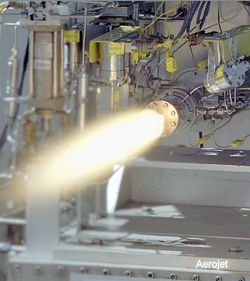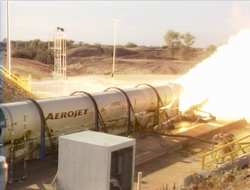NASA, Industry Consortium Successfully Test Full-Scale
Hypersonic Engine Thruster
 Aerojet says that NASA and the Rocket Based
Combined Cycle Consortium, or RBCCC, have taken an important step
in developing a new engine that could revolutionize access to space
and air transportation in the next quarter-century.
Aerojet says that NASA and the Rocket Based
Combined Cycle Consortium, or RBCCC, have taken an important step
in developing a new engine that could revolutionize access to space
and air transportation in the next quarter-century.
The consortium, of which Aerojet is a member, has successfully
completed the first in a series of tests of a full-scale rocket
thruster -- a crucial element of a rocket based combined cycle
engine system. The test, conducted at Aerojet facilities in
Sacramento (CA), marked a key milestone in NASA's Integrated System
Test of an Air-breathing Rocket (ISTAR) program.
 ISTAR intends, by the end of the decade, to
flight-test a self-powered hypersonic flight vehicle to more than
six times the speed of sound, demonstrating all modes of engine
operation. The small, high performance thrusters are intended to
power the engine system demonstrator during the early phase of
powered flight, accelerating the craft to hypersonic speed (~3,750
mph). At that point, the engine switches to pure air-breathing
ramjet and scramjet modes of operation.
ISTAR intends, by the end of the decade, to
flight-test a self-powered hypersonic flight vehicle to more than
six times the speed of sound, demonstrating all modes of engine
operation. The small, high performance thrusters are intended to
power the engine system demonstrator during the early phase of
powered flight, accelerating the craft to hypersonic speed (~3,750
mph). At that point, the engine switches to pure air-breathing
ramjet and scramjet modes of operation.
The test demonstrated the first successful hot fire of a
thruster using a mix of decomposed peroxide, liquid peroxide and
JP-7 jet fuel to generate combustion. This 90-percent peroxide
"tri-fluid" approach will allow the thrusters to fit within the
engine's extremely tight packaging restraints, yet deliver high
performance.
NASA's development of hypersonics technologies, including the
ISTAR program, is intended to support creation, by 2025, of flight
vehicles that will offer safe, routine, affordable space access and
air transportation to any point on the globe in less than two
hours.
"Our industry team continues to set the bar for hypersonic
research," said Steve Cook, deputy manager of the Next Generation
Launch Technology Program at NASA's Marshall Space Flight Center in
Huntsville (AL). "The flight research now being conducted by RBCCC
is unprecedented, pushing the envelope of powered flight like no
one has done since the Wright Brothers."
 The consortium team conducted two separate
thruster test series on behalf of the ISTAR program. The team
successfully decomposed liquid peroxide in a platelet catalyst bed
to supply hot oxygen to the combustion chamber as an ignition
source.
The consortium team conducted two separate
thruster test series on behalf of the ISTAR program. The team
successfully decomposed liquid peroxide in a platelet catalyst bed
to supply hot oxygen to the combustion chamber as an ignition
source.
Data gained from this test series -- particularly regarding
reaching 90 percent efficiency of the catalyst beds -- was the
first step needed to establish a start sequence for the full-scale
thruster. The platelet catalyst beds reached 90 percent efficiency
in six-tenths of a second.
Secondly, the team demonstrated tri-fluid combustion, or the
stable operation of decomposed and liquid peroxide and JP-7. The
goal of the test was to establish an ignition start sequence and to
characterize the use of liquid hydrogen peroxide to cool the
combustion chamber walls. A reliable start sequence was established
that minimized the start transient -- the abrupt and potentially
risky physical motion of the thrusters during ignition -- and
resulted in reaching full chamber pressure in less than one
second.
 The team will conduct longer-duration thruster
tests in early 2003.
The team will conduct longer-duration thruster
tests in early 2003.
RBCCC combines the propulsion development skills of the
Rocketdyne Propulsion & Power business of Boeing, Pratt &
Whitney, and Aerojet missile and space propulsion business, from
Sacramento. The team was tasked by the Marshall Center in late 2001
to design and develop the new rocket based combined cycle engine
system.
 ANN's Daily Aero-Term (04.20.24): Light Gun
ANN's Daily Aero-Term (04.20.24): Light Gun Aero-News: Quote of the Day (04.20.24)
Aero-News: Quote of the Day (04.20.24) ANN's Daily Aero-Linx (04.21.24)
ANN's Daily Aero-Linx (04.21.24) Aero-News: Quote of the Day (04.21.24)
Aero-News: Quote of the Day (04.21.24) ANN's Daily Aero-Term (04.21.24): Aircraft Conflict
ANN's Daily Aero-Term (04.21.24): Aircraft Conflict






